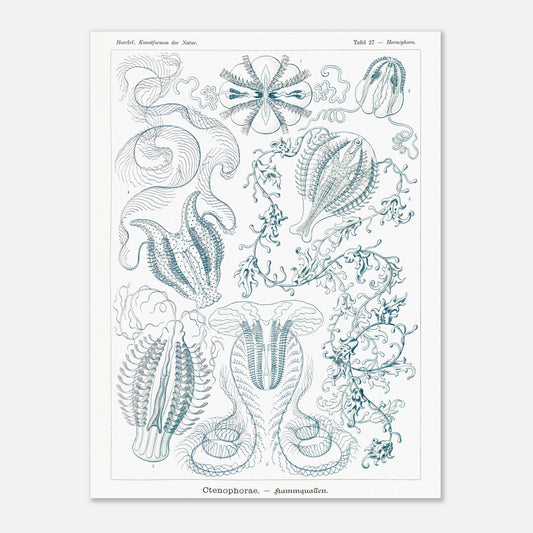Ctenophores - Old scientific engraving - Ernst Haeckel, Kunstformen der Natur
Ctenophores - Old scientific engraving - Ernst Haeckel, Kunstformen der Natur
Couldn't load pickup availability
Engraving reproduction of: Ctenophores
Original title Ctenophorae - Kammquallen
Poster of Hormiphora - Cnidarians of the class of Jellyfish or Ctenophores (Legion of Ctenophores)
Illustration from the book Kunstformen der Natur, which is a collection of artistic lithographs of natural sciences published by the German biologist Ernst Haeckel between 1899 and 1904.
This naturalistic illustration is part of an overall style inspired by Ernst Haeckel, which greatly influenced the emerging Art Nouveau movement at the beginning of the 20th century. This work, illustrating the impressive beauty and great diversity of the biological world, was complemented by a certain amount of scientific information, some excerpts of which are reproduced below.
This information is over 120 years old and some of it may be outdated!
Scientific classification:
Cnidarian Phylum (Cnidaria) Class Ctenophorae Legion of Cannocteniae (with simple ribbed canals) Order of Cydippe (Cydippeae)
Scientific notice (extract) accompanying the poster print of Ctenophorae - Ctenophores :
The comb jellies or comb jellies (Ctenophorae) form a very special class within the phylum Cnidaria; they are probably most closely related to the hydromedusae (Craspedotae) and have evolved from a branch of the anthomedusae (Plate 6, Fig. 14). All comb jellies live by swimming in the open sea and are distinguished by the extraordinary delicacy of their soft, gelatinous bodies. Its water content is usually between 96 and 99 percent, so that only 1 to 4 percent (or less) is due to the weight of animal tissue. Furthermore, the glassy body is usually completely transparent, so that its internal organization can be recognized without difficulty. Size is very variable; it is only a few millimeters in the smallest species, and more than a meter in the largest. The basic geometric shape of the body is very particular, its overall external form being sometimes almost spherical or ovoid, sometimes pear-shaped or melon-shaped. The internal organs and external appendages of the body are always arranged in such a way that the basic abstract geometric form is both tetraradial and bitranchant (the rhombic pyramid, i.e., a four-sided pyramid with a rhombus as its base). Of the three different and perpendicular directional axes that determine the basic shape, the first, the main axis, has unequal poles; at the lower end, the oral pole (buccal pole), is the mouth opening; at the upper end, the aboral pole (funnel pole), are the funnel and the nerve ganglion and the sensory organ. The other two directional axes have equal poles; In the shorter (sagittal) axis lies the laterally compressed pharynx (seen from above in Fig. 1, vertical); in the longer (lateral) axis, to the right and left, are the two long tentacles or prehensile filaments, which can retract into special tentacle pouches (horizontal in Fig. 1). The peculiar locomotor apparatus of the Ctenophores, to which the class also owes its name, is quite characteristic. It consists of eight rows of adradial ciliated combs or "ciliated ribs," which extend in shallow meridian arcs from one pole of the vertical main axis to the other. Each row of combs consists of a series of delicate, oscillating ciliated lamellae, which are attached at their broad base to the surface of the skin and divided at their free end into numerous delicate cilia. When the sun shines on the slowly swimming animals, the magnificent play of colors of a constantly changing rainbow is created by the interference of light. By the voluntary movements of these rows of cilia, which beat as regularly as the rows of oars on a galley, the delicate Ctenophores are slowly drawn into the sea. The internal structure of the body is similar to that of jellyfish. The mobile mouth opening (below) leads to a wide pharyngeal cavity; this continues upwards into a smaller gastric cavity, the so-called funnel. Above, this divides into two infundibular canals that surround the nerve ganglion located above, the apical brain, and the spherical sensory organ adjacent to the apical pole (Figs. 3 and 4). From the funnel, two strong nutrient canals branch off laterally, which divide twice in a fork-like fashion; Thus, each of the eight rows of cilia receives a "costal canal", in the wall of which the gonads develop, with a male gland on one side and a female gland on the other side of each canal.
Species present on the Ctenophores - Hormiphora naturalist board :
- Haeckelia rubra
- Hormiphora foliosa
- Callianira bialata
- Tinerfe cyanea
- Lampetia pancerina
About this print
About this print
The layout and composition of this reproduction have been the subject of our greatest attention.
- Respect for the format of the original work: in order to faithfully transcribe the artist's intention, the work is not cropped/re-cut except in extreme cases (obvious imperfection, geometry problem, etc.) in which case the cropping will be as light as possible.
- The presence of white margins is sometimes necessary in order to present the work in a balanced manner.
- Each size offered has been specifically composed, therefore, the size of the white margins may vary from one print size to another. Remember to check this detail carefully!
- Print only, frame not included!
Features
Features
- Premium 200gsm matte white paper, durable and strong.
- Natural, smooth uncoated finish, silky to the touch
- FSC certified paper or equivalent certifications depending on regional availability.
- Each print is shipped in sturdy packaging, ensuring safe transport.
- Each print is printed and shipped on demand. No minimum order quantity is required.
Share !









Recently viewed products
We are listening to you
If you are looking for a specific composition, a particular layout, or any other customization need, our team is at your disposal and will do everything possible to meet your requests.
So don't hesitate to...




